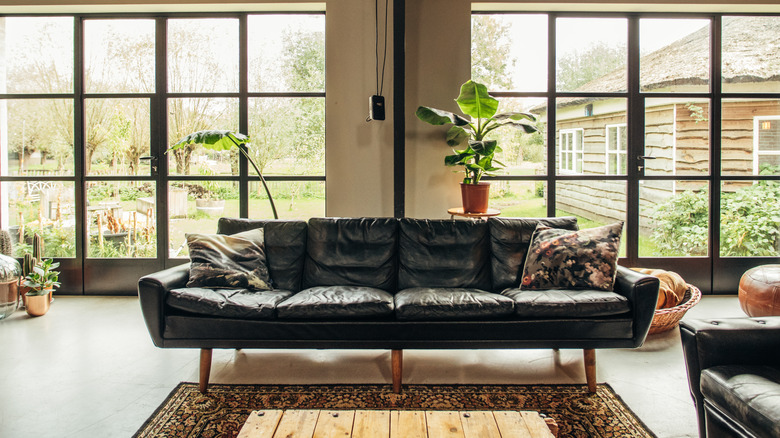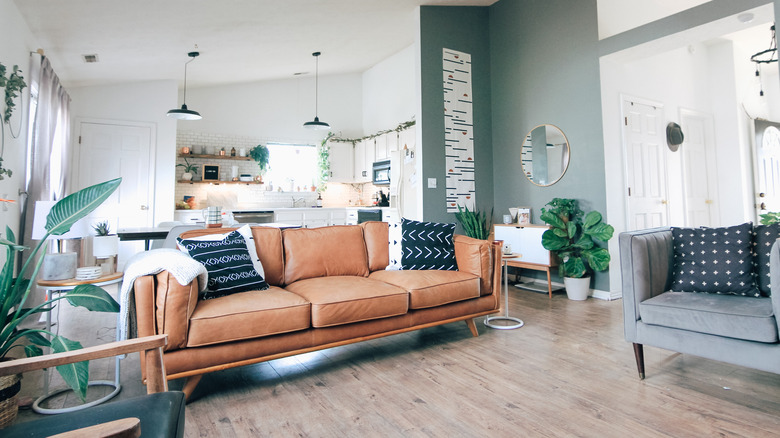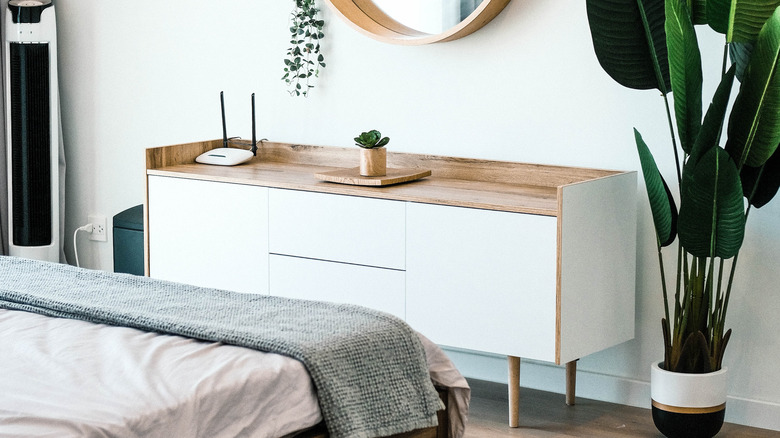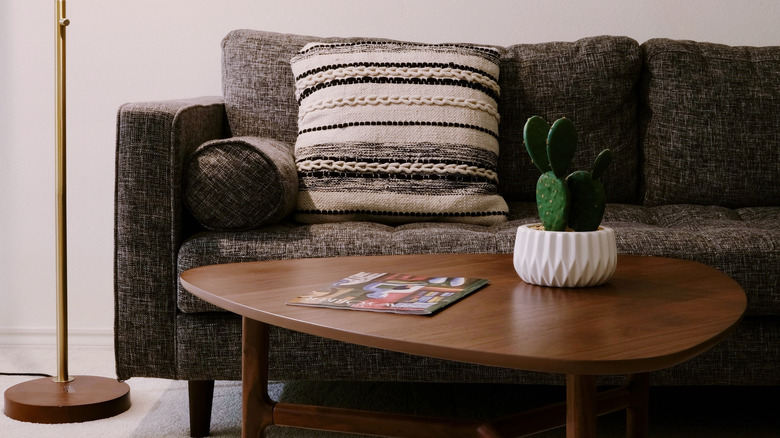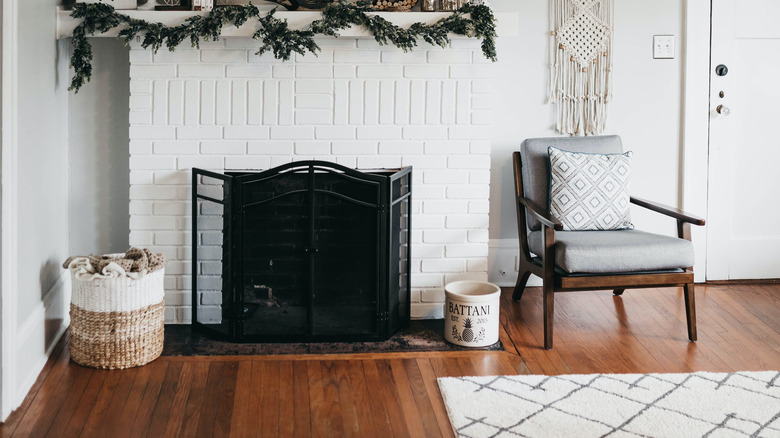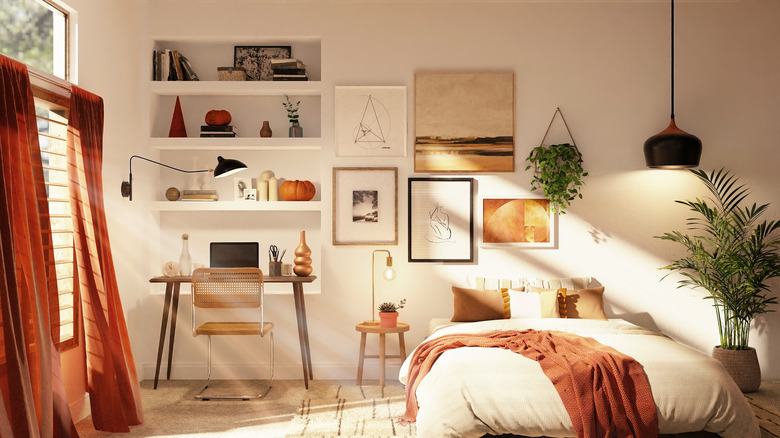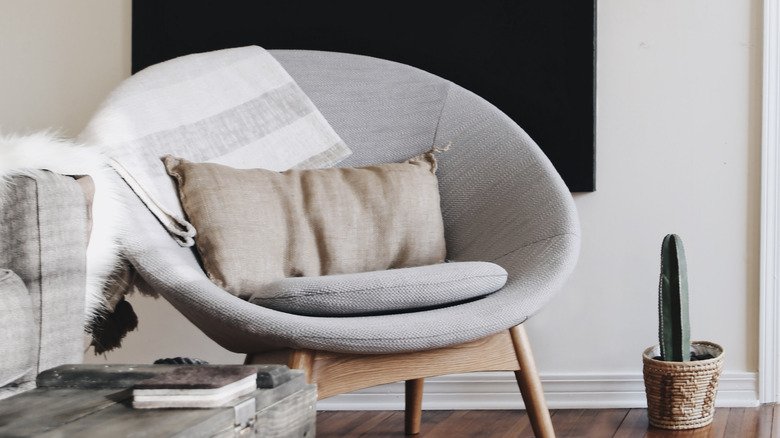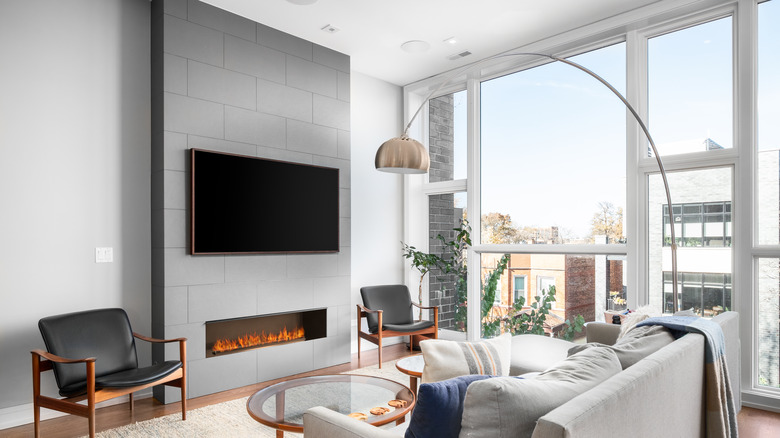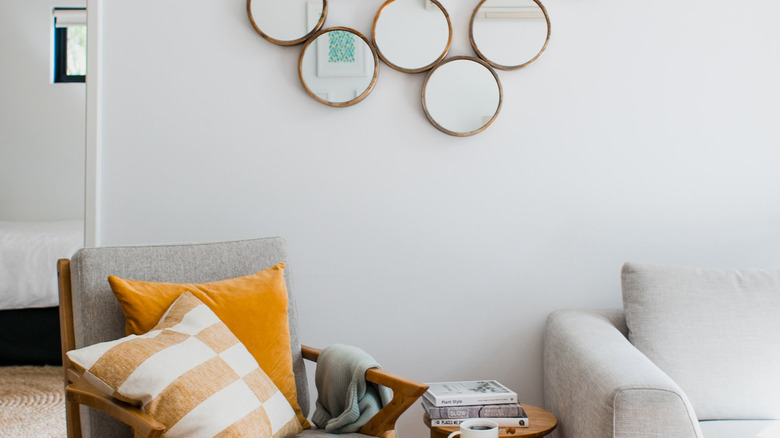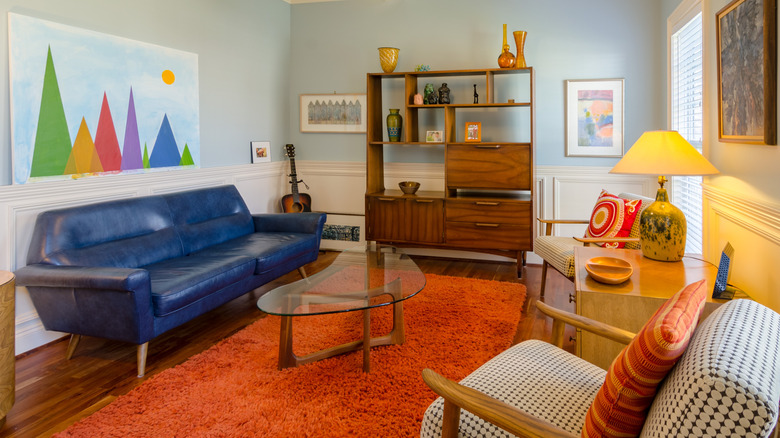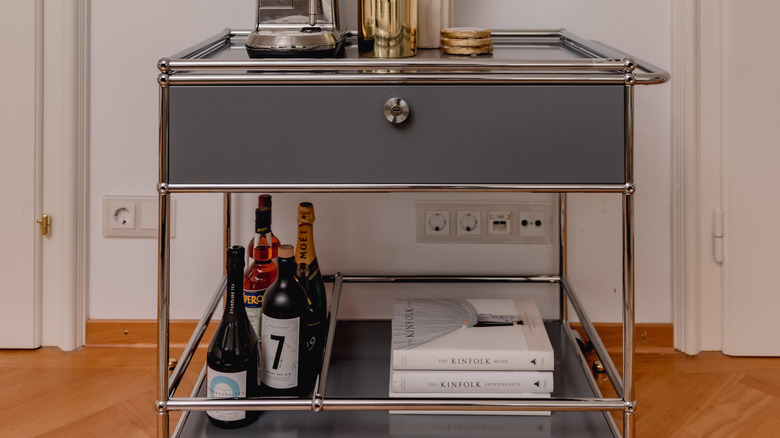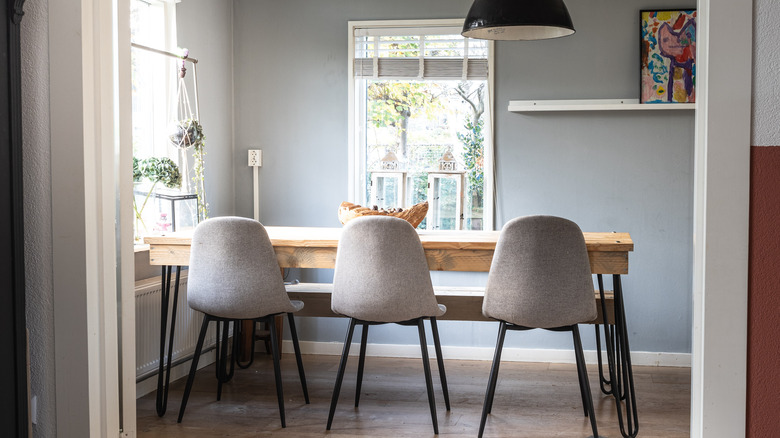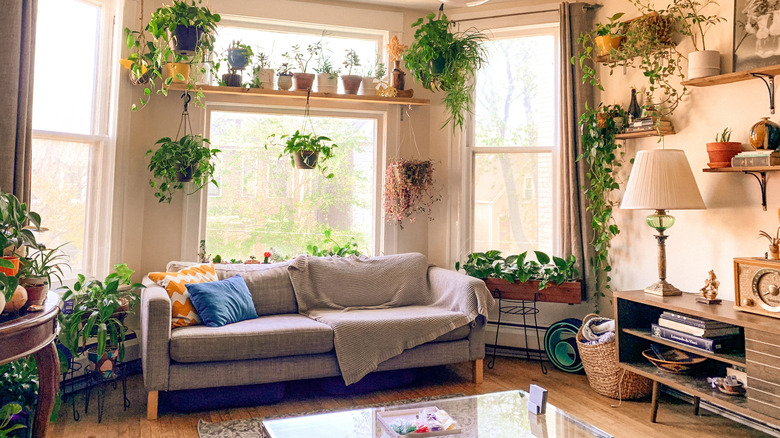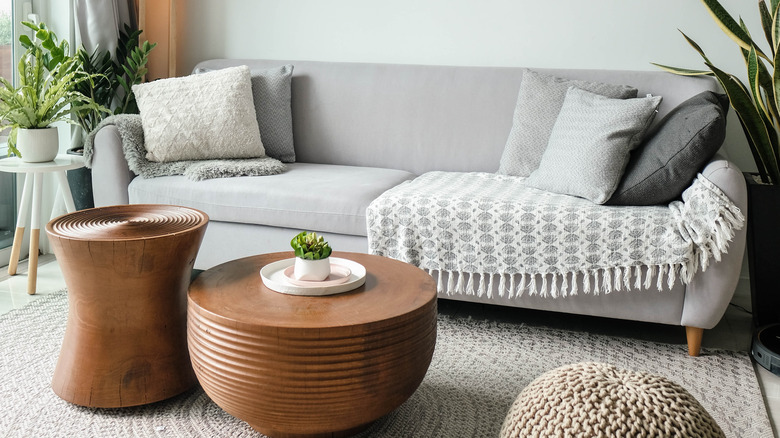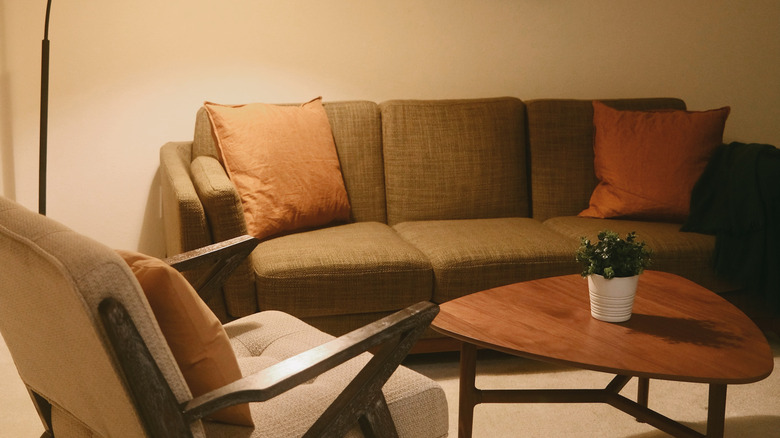The Ultimate Guide To Mid-Century Modern Decor
Mid-century modern design first became popular after World War II. Homeowners loved the unique design elements, which were completely opposite to what came before. According to Architectural Digest, mid-century furniture is often streamlined with simple shapes and natural influences. There is a strong emphasis on function with the notion pieces are built for everyone. The furnishings of this era typically feature wood, metal, glass, and vinyl materials.
Decorating with peg-leg furniture, credenzas, and sleek lamps is a good way to incorporate mid-century style into your home. Using organic materials can complement existing furnishings and instantly create an eclectic, mid-century vibe. For a more balanced look, layer soft elements with more structural ones. Round out the look with pops of color that brighten up the room and hints of greenery for an organic touch. Ready to freshen up your living space with a chic and timeless mid-century appeal? Check out this ultimate guide to mid-century modern decor.
Embrace the open layout
The arrival of mid-century modern decor also influenced more structural aspects of the home. According to MyDomaine, open-concept homes showed up in the designs of prominent architects such as Frank Lloyd Wright, Joseph Eichler, and Ludwig Miles van der Rohe. While rooms used to be independent of each other, now they started merging into one space without dividing walls. Open layout designs are now commonplace, with living rooms, dens, kitchens, and dining rooms connected in most modern home layouts. This open flow of space is part of what makes mid-century modern decor so appealing.
Keep openness the main focus when designing your mid-century modern home. Avoid overcrowding windows with furniture and plants. When arranging furniture in a room, ensure there is enough space between doorways and pathways for walking. It's best to leave at least 30 inches of space around furnishings and 14 to 18 inches between a coffee table and the sofa (via MyDomaine).
Maximize natural light
Natural light beautifully intensifies a space and accents your favorite decorative elements. According to Time, exposure to natural light is good for you and can even positively affect your mood and energy levels. Create an uplifting mood in your space by letting natural light flow in from the windows. Mid-century modern designs often emphasize sunlight, illuminating interiors with features like glass doors, large windows, and angled ceilings (via Mid-Century Home).
If natural light is low in your living space, incorporate brightening elements like a large round mirror. Mirrors reflect light and bounce it around a room, lighting up dark corners and creating the illusion of more space (via Apartment Therapy). You can leave your windows bare or decorate them with sheer curtains to maximize light. Light natural wood furnishings also help make a room feel brighter and more open. If you have a blend of different wood types, mix them. Combining wood furnishings creates contrast and maintains balance.
Soften the look with plush accessories
Mid-century modern decor can quickly feel office-like and stale if soft elements are ignored or left out. Strike a balance between industrial elements and soft textures by adding a bit of cloud-like texture to your home with a patterned pillow, cozy rug, or throw blanket. According to Hunker, this design style is incredibly tactile and usually incorporates soft textiles like velvet, leather, fur, mohair, and corduroy. Plush elements like chenille throws and feather stuffed pillows help soften an otherwise hard space.
You can also reupholster your favorite mid-century modern furniture with soft textures. Adding new fabric to old pieces is a great way to spruce them up. Look for abstract prints or geometric patterns to tie together the contemporary mid-century design. Since mid-century-modern furniture tends to be streamlined and machine-like, adding softer elements is pivotal for creating an environment where you enjoy spending time.
Focus on functionality
According to Decorilla, mid-century modern interiors typically adhere to a form-follows-function principle. Due to this design direction, furniture items associated with mid-century tend to take up less space than vintage pieces from previous eras. Furniture construction focuses on performance and how a specific piece functions within a home. There's nothing over-the-top or excessive about this design style.
Style your mid-century modern home by opting for functional and versatile furniture with simple shapes (via Homes & Gardens). Look for clean lines, slimline legs, and organic curves when shopping for pieces online or at local stores. Ideally, aim to decorate your house with furnishings that add function. If you live in a small apartment or townhouse, consider adding a coffee table with built-in storage. Try to pick decor that provides a solution and fits your unique style. Every item in a room should serve a purpose and contribute to your daily life.
Add pops of color to a neutral palette
In mid-century modern designs, white and neutral walls are a common sight. According to Michael Helwig Interiors, this neutral base allows color to shine through in other decor elements. You can incorporate pops of color through accessories, chairs, art, pillows, and rugs.
To breathe vibrant color into your space, consider adding doses of color around the room. The shades do not have to be identical but should complement each other. A great way to establish cohesiveness is to blend shades from the same color family. Vibrant colors and earthy tones effortlessly complement mid-century modern style as they pair well with wood tones. Think about trimming white walls with an earthy shade of green or a golden yellow. Bright tones like sweet purples and blues are also a staple of this design style. When decorating, avoid over-saturating the space with too much color.
Incorporate timeless furniture
The key to achieving mid-century modern style is selecting the right furniture. According to The Manual, characteristics of this era include clean lines, low profiles, and tapered legs. Say goodbye to chunky, ornate furnishings and hello to streamlined pieces. The beauty of these minimalist furnishings is in their shape. Some of the most iconic furnishings from the era include the Eames lounge chair and ottoman, Wassily chair, and Florence Knoll sofa.
Mid-century modern furniture belongs to three different categories: biomorphic, machine, and handcrafted. Biomorphic furniture pieces tend to be more smooth and curved, similar to a kidney bean shape with sloping edges (via Homedit). Machine-inspired furnishings feature a hard exterior and metal details. Handcrafted pieces usually feature high-quality craftsmanship, rich wood material, and tapered legs. Mid-century furnishings feature a combination of natural and synthetic elements. Wood, leather, lucite, and vinyl are all common materials used for furnishings.
Look for large scale lighting
Try to focus some decorating efforts on lighting up your living space with cool light fixtures, especially those that add function. According to Better Homes and Gardens, opting for quirky pendant lighting or large-scale, saucer-shaped light fixtures is a great way to add a focal point and visual interest to a space. Consider a uniquely shaped light fixture with flowing curves or iconic pieces like burst chandeliers, gold-dipped globes, saucer or hourglass-shaped pendants, and industrial fixtures with brass finishes. Any of these options would perfectly complement mid-century modern decor.
If ceiling lighting does not need updating, consider adding a floor lamp. Oversized lamp shades are perfect for brightening up dark corners of the room. You could set two lamps with cone-shaped lampshades on a table behind a sofa to create an inviting lighting concept. Using this lighting technique allows you to showcase oversized light fixtures uniquely.
Mix materials for a modern twist
According to The Spruce, a defining aspect of mid-century modern style is mixing different materials. Pairing wood with metal, glass, or vinyl creates contrast and gives your home a modern twist. To nail the aesthetic, aim to mix synthetic materials like lucite, fiberglass, and plastic with natural materials like wood, glass, and marble (via MasterClass). But don't stop there. Along with mixing materials, you can also layer your mid-century pieces with vintage-inspired furnishings to create an extra layer of contrast.
When shopping for furniture, look for curved wood credenzas, metal sideboards, and fiberglass buffets. Not every piece of furniture needs to have a distinctive shape, but squares and rectangular styles are a popular feature of mid-century modern homes. If your living room has a lot of natural wooden furnishings, mix it up and create a more open space by adding a glass coffee table.
Contrast playful patterns with minimalist shapes
Geometric furniture is a staple in mid-century modern decor. To prevent sleek shapes from looking drab, liven them up with a bright color palette and playful patterns. For example, place a large rectangular black sofa in your living room and complement it with vibrant wall art or a boldly patterned armchair. Furnishings such as these are ideal for creating a mid-century modern look in your home.
Bring a sense of balance to the minimalist furniture with patterns. According to Homedit, accessories like shag rugs, ceramic artwork, and textured upholstery add visual interest. You can also incorporate abstract prints on pillows, blankets, and carpets to create surface movement and break up space in an otherwise static room. Websites like Etsy and Wayfair offer a wide selection of mid-century modern abstract prints for every budget. Cover your walls with these colorful prints to make an eclectic statement.
Design a stylish bar cart
Happy hour anyone? Bring the 1960s to life in your home by adding a bar cart to the living room, dining area, or kitchen. This fun element will surely elevate the mid-century modern look in any room. To help your bar cart reach its full potential, organize the shelves with essentials like coasters, canisters, napkins, utensils, and dessert plates. Add a fresh coat of gold paint or add seasonal decorations for stylish sparkle.
According to Elle Decor, you should let your creativity flow while designing your bar cart. Weave in colorful glassware to make a statement and add depth with decorative elements like stylish glassware, bottles, shakers, snacks, or floral arrangements. If space is restricted, consider adding bar cart elements to an existing furniture piece like a credenza or small side table (via Insider). This trick boosts functionality in the space and allows you to use items in multiple ways.
Decorate with iconic accent chairs
Accent chairs hold both functional and decorative purposes. They can be used as dining chairs, living room chairs, or tucked away in a bedroom for additional seating or clothing storage. Add a few striking accent chairs to your space to achieve a mid-century modern look in your home. Mid-century modern accent chairs are distinct and timeless. The simple form, geometric prints, natural wood finishes, clean lines, and soft curves are classic and pair effortlessly with any living space.
According to Curated Interior, mid-century modern furniture combines form and function. While previous design styles placed visual appearance above all else, the mid-century style values function and practicality. When selecting furniture for your space, opt for some funky butterfly, womb, or tulip-shaped chairs. These funky shapes elevate the modern vibe with sleek, streamlined edges commonly seen in mid-century decor. Choose accent chairs that are adaptable and comfortable.
Incorporate plants for a natural touch
Mid-century modern decor effortlessly blends industrial pieces with natural components. According to MasterClass, houseplants are often incorporated in this streamlined style to fuse indoor and outdoor elements and liven up a living space. Adding lush greenery to your home brings dimension and organically introduces texture.
You don't need a green thumb to own plants. Consider placing a fiddle leaf fig or dragon tree in the corner of a room for a breath of fresh air. Both of these plants are easy to take care of and grow well in medium light. If you want to add greenery on a smaller scale, choose rubber plants, orchids, or snake plants and place them on tabletops or plant stands. These plants might be familiar to you as they are popular choices for the home, and you'll soon see why that popularity is warranted.
Stick to basic accessories
Mid-century modern decor is typically simple without too many competing visual elements. You'll often see several large statement pieces in a room, like bold sofas or dramatic floor lamps. However, smaller items and decorative trinkets are out of view. According to La Résidence, it only takes a few pieces to complete the style. Keep this in mind when decorating tabletops, counters, and bookshelves. Stick to basics like a small stack of books, candles, plants, and a vase with fresh flowers. While accessories in a mid-century modern room may be minimal, they still make a powerful statement.
For a cohesive look, focus on functionality throughout the entire space. A golden rule to follow is to only decorate with purposeful items. Hide clutter in cabinets, drawers, boxes, or decorative storage baskets. If a table is not necessary, place woven baskets in corners of the room to store blankets and stack boxes on tabletops to hold remotes, electronics, and other knickknacks.
Futuristically furnish your space
One way to successfully decorate with a mid-century style is to understand its core theme. According to Living Spaces, the space race between the United States and Russia during the 1950s and 1960s inspired America to go crazy for futuristic themes in objects like clothes, TV shows, and homes. People were inspired by these iconic designs and contemporary forms — many of which are still popular today.
If you look across a catalog with mid-century-inspired furniture ideas, you will see a wide variety of futuristic shapes. There are wooden tables with rounded edges, tapered legs under oval buffets, saucer lamp shades with exposed bulbs, and overarching floor lamps with globes dangling at the end. While these pieces are futuristic, they also draw inspiration from the past (via House Beautiful). For example, the iconic Eames lounger took the class club chair and gave it a modern twist. When decorating your home, think about ways to transform your classic pieces for the future.
